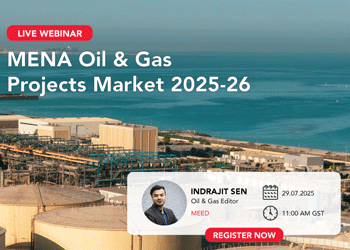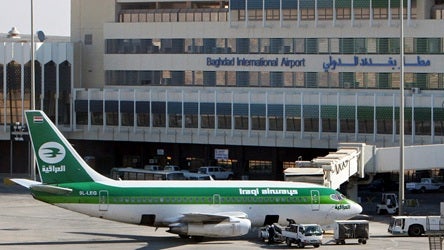Working towards a common energy-transition goal
28 November 2022
Published in partnership with

In the end, it went right to the wire. Just as it looked like the UN’s 27th Conference of the Parties (Cop27) would conclude without an accord, the weary delegates announced that they had reached a landmark agreement on setting up a fund to help compensate poorer nations for the economic and social destruction caused by climate change.
The statement, two days after the Sharm el-Sheikh summit’s original 18 November end date, was a culmination of some 30 years of negotiations between developed economies and developing nations. The latter had long argued that the damage they have experienced from global warming should be paid for by richer countries responsible for the crisis in the first place.
Although far from perfect, the global ‘loss and damage’ fund was hailed as an important and symbolic step towards hitting the agreed target of limiting global temperature increases to 1.5C above pre-industrial levels by 2030. It also marked the continuing engagement and collaboration by governments across the globe.
“We rose to the occasion,” said Egypt’s Minister of Foreign Affairs and president of Cop27 Sameh Shoukry.
“We worked around the clock, day and night, but united in working for one gain, one higher purpose, one common goal. In the end, we delivered. We listened to the calls of anguish and despair.”
Private sector involvement
While Cop27 has been and will continue to be a policy-setting mechanism negotiated at the highest level, companies played a critical role during the conference.
Firms representing a broad range of sectors, including Vodafone, Microsoft, Boston Consulting Group and Bloomberg, partnered with the event, and many more participated in the main conference and exhibition areas.
Ultimately, governments understand that the private sector will lead the drive towards net zero. Without corporates worldwide investing in clean energy projects and technology, there is little hope that targets will be reached.
 Five consistency points
Five consistency points
A key supporter of Cop27 was Siemens Energy. Sharing its expertise through panels covering subjects as varied as the Mediterranean’s North-South Energy Partnership, improving power access in Africa by unlocking its green hydrogen potential, and overcoming the challenges of decarbonisation, the energy technology company played a pivotal role in discussions and thought leadership.
It also participated in the world leader’s summit at a roundtable discussing green hydrogen, reinforcing its positioning of energy transition at the heart of its strategy.
Before the Sharm el-Sheikh conference, Siemens Energy president and CEO Christian Bruch outlined five points of consistency that his company considers to be unifying elements in the decarbonisation drive.
The first is the acceleration of renewables. Replacing conventional power generation systems with solar, wind, hydro and other forms of renewable energy is essential to reduce greenhouse emissions.
Despite a considerable increase in the overall share of renewables in the past three years on the back of ever-lowering costs and more efficient technology, more must still be done.
For example, the US needs to triple its share of renewable energy as a proportion of the energy mix by 2050 for the energy transition to succeed. The Asia-Pacific region, meanwhile, will have to increase this figure fourfold.
Regional targets
In the Middle East, every country has now set ambitious targets to increase renewable energy. The likes of Saudi Arabia, Morocco and the UAE are aiming for renewables to account for up to 50 per cent of total production by 2030. To reach these objectives, almost all new power generation projects come in the form of renewables.
However, the impact of greener electricity production could be somewhat offset by continuing demand growth caused by an increasing global population and economic growth.
In this context, the second point is the requirement for improved energy conservation measures, such as policies to incentivise the electrification of industry and transport.
Regionally, the industrial electrification of energy-intensive industries is an optimal opportunity to reduce harmful emissions by harnessing electric boilers and/or electricity-based fuels. Future large-scale blue and green hydrogen production will also have a role to play in industrial processes.
Siemens Energy’s third point of consistency is improving electrical efficiency. The increase in renewable energy capacity and the growth in power capacity, in general, require significant investment in transmission and distribution networks.
This is particularly important in areas such as sub-Saharan Africa, where almost 25 per cent of the population has little to no access to electricity.
The fourth point covers the requirement to use existing conventional power infrastructure to help bridge the gap between the fossil-fuelled economies of today and the net zero of tomorrow.
Progress cannot be made in one step alone and requires a gradual transition. In the meantime, existing thermal plants can employ measures such as combined-cycle technology and carbon capture to make them as efficient and environmentally friendly as possible.
The energy transition is the biggest investment programme since the dawn of industrialisation. If governments, business and society work together, energy transition is a massive opportunity
Christian Bruch, Siemens Energy president and CEO
Mineral production
Finally, to achieve all of this, it is necessary to improve supply chains and increase the production of necessary minerals and rare earth metals required in net-zero technologies, such as lithium, nickel, cobalt and chromium.
Bruch gives the example of a typical electric car, which requires six times more mineral inputs than one powered by an internal combustion engine. He also cites onshore wind plants, which need nine times more than a gas-fired power plant.
If mineral production is not increased and geographically diversified, there is a risk of future supply bottlenecks.
In the Middle East, a good illustration of this is the potential future supply gap for electrolyser systems, and the anodes and cathodes typically made from metals such as zinc, nickel and lithium.
MEED estimates that about 75GW of electrolyser production capacity will be required by 2030 to meet the demand for the raft of planned green hydrogen plants in the region alone, compared with a total global output capacity of just 8GW today.
 Industrial decarbonisation alliance
Industrial decarbonisation alliance
All five consistency points make salient arguments. However, they can only be achieved with close cooperation between the private and public sectors. While the former can spearhead and implement the decarbonisation drive, the latter can provide the regulations and incentives to encourage these initiatives.
The newly formed Alliance for Industry Decarbonization initiated by Siemens Energy and coordinated and facilitated by the Abu Dhabi-based International Renewable Energy Agency (IRENA) is an example of greater collaboration between the public and private sectors.
The 28-member alliance – which encompasses a range of global energy, renewable, consulting and manufacturing companies – met for the first time during Cop27 to outline its joint vision and implementation plan. Its strategy focuses on six pillars and enablers that tie into the points of consistency: renewables, green hydrogen, bioenergy with carbon capture, utilisation and storage (CCUS), heat process optimisation, human capital and finance.
Only through this kind of stakeholder dialogue can the immense and existential challenges posed by global warming be overcome. Governments or companies acting in isolation will only achieve so much on their own. The points of consistency must be considered as a whole and in unison if the world’s climate objectives are to succeed.
As Bruch says: “The energy transition is the biggest investment programme since the dawn of industrialisation. If governments, business and society work together, energy transition is a massive opportunity. There is no excuse for waiting any longer.”
Related reads:
- New alliance forged to accelerate net-zero ambitions
- The journey towards net zero
- Solving Europe’s energy challenge
- Africa’s energy trilemma
- Region primed for global green hydrogen leadership
Exclusive from Meed
-
 WEBINAR: Mena Oil & Gas Projects Market 2025-26
WEBINAR: Mena Oil & Gas Projects Market 2025-2610 July 2025
-

-
 Chinese firm wins Mid Island Parkway tunnelling deal
Chinese firm wins Mid Island Parkway tunnelling deal10 July 2025
-
 Iraq tenders Baghdad airport PPP project
Iraq tenders Baghdad airport PPP project9 July 2025
-

All of this is only 1% of what MEED.com has to offer
Subscribe now and unlock all the 153,671 articles on MEED.com
- All the latest news, data, and market intelligence across MENA at your fingerprints
- First-hand updates and inside information on projects, clients and competitors that matter to you
- 20 years' archive of information, data, and news for you to access at your convenience
- Strategize to succeed and minimise risks with timely analysis of current and future market trends

Related Articles
-
 WEBINAR: Mena Oil & Gas Projects Market 2025-26
WEBINAR: Mena Oil & Gas Projects Market 2025-2610 July 2025
Date & Time: Tuesday 29 July 2025 | 11:00 AM GST
Agenda:
1. Summary of the Mena oil, gas and petrochemicals projects market
2. Summary description of the main megaprojects, including project programmes
3. Analysis of active contracts and spending to date
4. Analysis of top contracts by work already awarded
5. Long-term capital expenditure outlays and forecasts
6. Highlights of key contracts to be tendered and awarded over the next 18 months
7. Top contractors and clients
8. Breakdown of spending by segment, ie, oil, gas, petrochemicals – upstream, downstream, onshore and offshore
9. Q&A session
https://image.digitalinsightresearch.in/uploads/NewsArticle/14241705/main.gif -
 New Murabba signs up South Korean firm for design works
New Murabba signs up South Korean firm for design works10 July 2025
Register for MEED’s 14-day trial access
Saudi Arabia’s New Murabba Development Company (NMDC) has signed a memorandum of understanding (MoU) with South Korea’s Heerim Architects & Planners to explore further design works on assets at the 14 square-kilometre New Murabba downtown project.
According to an official statement: “Heerim Architects & Planners will explore distinctive architectural plans that complement the development’s masterplan, with special focus on anchor assets, linear parks and smart city features.”
New Murabba CEO Michael Dyke signed the agreement last week during the company’s Investment and Partnership Forum in Seoul.
At the event, NMDC also signed an MoU with South Korea’s Naver Cloud Corporation to explore technological solutions for delivering the New Murabba downtown project.
According to an official statement: “The three-year agreement covers exploring innovative technology and automation to support the delivery of New Murabba, including robotics, autonomous vehicles, a smart city platform and digital solutions for monitoring construction progress.”
NMDC is in Seoul to examine technological offerings, assess financing options and showcase the investment opportunities available for the New Murabba downtown development.
The statement added that the excavation works for The Mukaab, the centrepiece of the overall development, have now been completed.
The Mukaab is a Najdi-inspired landmark that will be one of the largest buildings in the world. It will be 400 metres high, 400 metres wide and 400 metres long. Internally, it will have a tower on top of a spiral base and a structure featuring 2 million square metres (sq m) of floor space designated for hospitality. It will feature commercial spaces, cultural and tourist attractions, residential and hotel units, and recreational facilities.
Downtown destination
The New Murabba destination will have a total floor area of more than 25 million sq m and feature more than 104,000 residential units, 9,000 hotel rooms and over 980,000 sq m of retail space.
The scheme will include 1.4 million sq m of office space, 620,000 sq m of leisure facilities and 1.8 million sq m of space dedicated to community facilities.
The project will be developed around the concept of sustainability and will include green spaces and walking and cycling paths to promote active lifestyles and community activities.
The living, working and entertainment facilities will be developed within a 15-minute walking radius. The area will use an internal transport system and will be about a 20-minute drive from the airport.
The downtown area will feature a museum, a technology and design university, an immersive, multipurpose theatre, and more than 80 entertainment and cultural venues.
 READ THE JULY 2025 MEED BUSINESS REVIEW – click here to view PDF
READ THE JULY 2025 MEED BUSINESS REVIEW – click here to view PDFUAE and Turkiye expand business links; Renewed hope lies on the horizon for trouble-beset Levant region; Gulf real estate momentum continues even as concerns emerge
Distributed to senior decision-makers in the region and around the world, the July 2025 edition of MEED Business Review includes:
> AGENDA: UAE-Turkiye trade gains momentum> INTERVIEW 1: Building on UAE-Turkiye trade> INTERVIEW 2: Turkiye's Kalyon goes global> INTERVIEW 3: Strengthening UAE-Turkiye financial links> INTERVIEW 4: Turkish Airlines plans further growth> CURRENT AFFAIRS: Middle East tensions could reduce gas investments> GCC REAL ESTATE: Gulf real estate faces a more nuanced reality> PROJECTS MARKET: GCC projects market collapses> INTERVIEW 5: Hassan Allam eyes role in Saudi Arabia’s transformation> INTERVIEW 6: Aseer region seeks new investments for Saudi Arabia> LEADERSHIP: Nuclear power makes a global comeback> LEVANT MARKET FOCUS: Levant states wrestle regional pressures> GULF PROJECTS INDEX: Gulf projects index continues climb> CONTRACT AWARDS: Mena contract award activity remains subdued> ECONOMIC DATA: Data drives regional projects> OPINION: A farcical tragedy that no one can endTo see previous issues of MEED Business Review, please click herehttps://image.digitalinsightresearch.in/uploads/NewsArticle/14239016/main.jpg -
 Chinese firm wins Mid Island Parkway tunnelling deal
Chinese firm wins Mid Island Parkway tunnelling deal10 July 2025

Register for MEED’s 14-day trial access
Beijing-headquartered China Railway Tunnel Engineering Group has won a $60m subcontract for the tunnelling works on package 1B of the Mid Island Parkway project in Abu Dhabi.
Package 1B entails the construction of a cut-and-cover tunnel to cross the Khor Laffan Channel, which is the area between the Saadiyat and Um-Yifeenah islands.
The tunnel, which will be between 900 metres and 1 kilometre (km) long, is being constructed on a design-and-build basis and will tie in to packages 1A and 1C.
The project is being jointly constructed by a joint venture of local firm Yas Projects (Alpha Dhabi Holding) and Beijing-based China Railway International Group.
In June last year, MEED exclusively reported that Abu Dhabi's Department of Municipality & Transport had awarded contracts for three packages for phase one of the Mid Island Parkway Project (MIPP), as part of the Plan Capital urban evolution programme.
Phase one will start at the existing Saadiyat Interchange, which will connect the E12 road to the MIPP, and will end with the recently constructed Um-Yifeenah Highway.
It comprises a dual main road with a total length of 8km, including four traffic lanes in each direction, two interchanges, a tunnel and associated infrastructure works.
MIPP phase one is further divided into packages 1A, 1B and 1C, which were awarded separately.
The project ownership has been transferred from Aldar Properties to Abu Dhaibi's Department of Municipalities & Transport.
Previously, it was transferred from Abu Dhabi General Services Company (Musanada) to Aldar Properties, and the project was included in the Abu Dhabi Investment Office's public-private partnership project pipeline.
 READ THE JULY 2025 MEED BUSINESS REVIEW – click here to view PDF
READ THE JULY 2025 MEED BUSINESS REVIEW – click here to view PDFUAE and Turkiye expand business links; Renewed hope lies on the horizon for trouble-beset Levant region; Gulf real estate momentum continues even as concerns emerge
Distributed to senior decision-makers in the region and around the world, the July 2025 edition of MEED Business Review includes:
> AGENDA: UAE-Turkiye trade gains momentum> INTERVIEW 1: Building on UAE-Turkiye trade> INTERVIEW 2: Turkiye's Kalyon goes global> INTERVIEW 3: Strengthening UAE-Turkiye financial links> INTERVIEW 4: Turkish Airlines plans further growth> CURRENT AFFAIRS: Middle East tensions could reduce gas investments> GCC REAL ESTATE: Gulf real estate faces a more nuanced reality> PROJECTS MARKET: GCC projects market collapses> INTERVIEW 5: Hassan Allam eyes role in Saudi Arabia’s transformation> INTERVIEW 6: Aseer region seeks new investments for Saudi Arabia> LEADERSHIP: Nuclear power makes a global comeback> LEVANT MARKET FOCUS: Levant states wrestle regional pressures> GULF PROJECTS INDEX: Gulf projects index continues climb> CONTRACT AWARDS: Mena contract award activity remains subdued> ECONOMIC DATA: Data drives regional projects> OPINION: A farcical tragedy that no one can endTo see previous issues of MEED Business Review, please click herehttps://image.digitalinsightresearch.in/uploads/NewsArticle/14238039/main3047.gif -
 Iraq tenders Baghdad airport PPP project
Iraq tenders Baghdad airport PPP project9 July 2025
Register for MEED’s 14-day trial access
Iraq’s Ministry of Transport and the General Company for Airport & Air Navigation Services have released a tender inviting firms to bid for a contract to develop Baghdad International airport on a public-private partnership (PPP) basis.
The notice was issued in July, and the submission deadline is in September.
According to an official statement posted on its website, Iraq’s Ministry of Transport said that 10 out of 14 international consortiums that expressed interest in the project earlier this year have been prequalified to compete for the tender.
The scope of the estimated $400m-$600m project involves rehabilitating, expanding, financing, operating and maintaining the airport. It is the first airport PPP project to be launched in Iraq.
The initial capacity of the airport is expected to be around 9 million passengers, which will be gradually increased to 15 million passengers.
The International Finance Corporation (IFC), a member of the World Bank Group, is the project’s lead transaction adviser.
Iraq is already developing the Baghdad and Najaf-Karbala metro projects using a similar PPP model.
Earlier this month, MEED reported that Iraq intends to retender the contract to develop and operate the Baghdad Metro project, following the award of the estimated $2.5bn contract last year.
According to local media reports, Nasser Al-Assadi, adviser to Prime Minister Mohammed Sudani, stated that the previous developers had overestimated the project budget; therefore, the government will relaunch the entire process to implement the project.
https://image.digitalinsightresearch.in/uploads/NewsArticle/14229008/main.jpg -
 Contractors prepare revised bids for Roshn stadium
Contractors prepare revised bids for Roshn stadium9 July 2025

Register for MEED’s 14-day trial access
Saudi gigaproject developer Roshn has invited firms to submit revised commercial proposals by 24 July for a contract to build a new stadium adjacent to the National Guard facilities to the southwest of Riyadh.
Known as the National Guard Stadium, it will be delivered on an early contractor involvement (ECI) basis. It will cover an area of over 450,000 square metres and be able to accommodate 46,000 spectators.
The scope of work also covers the construction of auxiliary facilities, including training academy offices and two hotels, as well as retail and food and beverage outlets.
The firms had initially submitted bids on 8 April for the contract.
The stadium is scheduled to host 32 Fifa World Cup tournament games in 2034.
In August last year, MEED reported that Saudi Arabia plans to build 11 new stadiums as part of its bid to host the 2034 Fifa World Cup.
Eight stadiums will be located in Riyadh, four in Jeddah and one each in Al-Khobar, Abha and Neom.
The proposal outlines an additional 10 cities that will host training bases. These are Al-Baha, Jazan, Taif, Medina, Al-Ula, Umluj, Tabuk, Hail, Al-Ahsa and Buraidah.
The bid proposes 134 training sites across the kingdom, including 61 existing facilities and 73 new training venues.
The kingdom was officially selected to host the 2034 Fifa World Cup through an online convention of Fifa member associations at the Fifa congress on 11 December 2024.
 https://image.digitalinsightresearch.in/uploads/NewsArticle/14228507/main.jpg
https://image.digitalinsightresearch.in/uploads/NewsArticle/14228507/main.jpg

